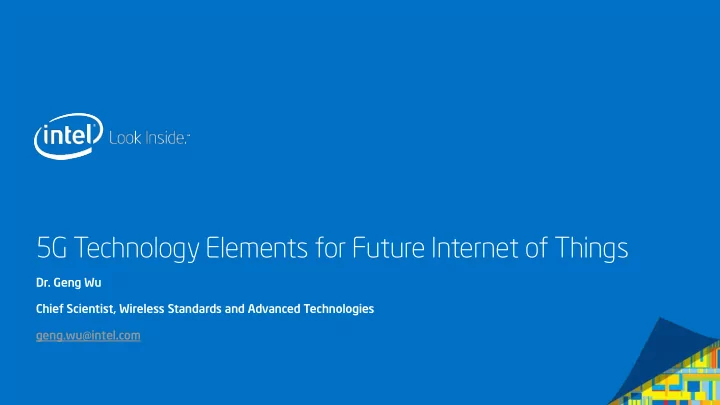

5G Technology Elements for Future Internet of Things Dr. Geng Wu Chief Scientist, Wireless Standards and Advanced Technologies geng.wu@intel.com
The future of Internet of Things Applications Ecosystem M2M Vertical Wearables IoT Horizontal 1x 10x - 100x Smart phones Smart things Future IOT requires new network capabilities to Future IOT requires close partnership among many support massive number of devices, and efficient industries and ecosystems to offer integrated SW/HW platforms for both devices and networks compute and communication capabilities 2
IOT expectation gaps Source Bain: Reflects n=37 interviews with tier 1 leaders in Smart Factory, Smart Building, Smart Fleet, Smart Grid Substation and Smart City Environmental Sensing domain 3
Enabling future IOT Technologies Standards and regulations *IDC **IMC/EDC: The digital universe of opportunities IOT requires end-to-end design considerations, from Standards collaboration and regulatory compliance sensors to the cloud are essential 4
5G design goals 5G IoT IoT 4G 4G mmWave Data rate Can be very low 100s Mbps 1-10 Gbps Latency From 2 ms to hours Moderate 2 ms Battery life Up to 10 years Smart phone Depends on app Link budget Penetration Coverage High data rate Multiple access Massive # of devices Smart phones Bursty/opportunistic Network Overlay Hetnet Hetnet/underlay 5G has to be designed as a system Compute + communication becomes a necessity 5
Air interface for IOT 5G 4G Machine Ma ine-Mac Machine hine in inter erac actio tion Latency 1s ms Direct link or tactile Internet Ultr tra-hi high gh data ta rate te Wear arab able le under erlay y networ orks Human-Human High peak to average Varying latency req. Human-Machine Short range, opportunistic Ad-hoc networks Interaction Het-net carrier aggregation Latency 10s ms Senso sor r Netw twork rk Latency often less an issue Massive # of devices Platform innovations enable applications/services innovations 6
Underlay networks for things and wearables Mesh Data on WiFi Direct Discovery and One big intelligent and information network control on LTE D2D Cluster #4 Compute, storage, networking D2D Coordinator Pico/Home Pico/Home eNB eNB D2D Unicast Link D2D Cluster #0 Macro Multi-hop Spatial Reuse in eNB One Cell Area D2D D2D Unicast Coordinator Link D2D Unicast D2D D2D Cluster #3 Link Broadcast D2D Cluster #1 Link Smart Apps D2D Coordinator D2D Cluster #2 D2D Broadcasting Many devices, types of devices, connections Many moving underlay network clusters Context-based Storage Processing 7
Virtualization of device and access 5G Devi vice ce + A Acc ccess ss Compute Platform Virtual aliz ization ion Performance 5G 5G Portab able Smart Featur ure Phone Wearab able le Phone Time 5G device+access virtualization for scalability, versatility, energy efficiency • 5G services are immersive. Sensing, intelligence and contents • Future applications require intensified compute and communication but often smaller device form factor require edge cloud and device + access virtualization • Breaking computing barrier through communication may • 5G high data rate + low latency radio links enable mobile device + access virtualization across the air interfaces transform consumers’ relationship with network 8
Future research areas System design Remote user access M2M Peer to peer Server Social Compute and communications tradeoffs network Device and access network architecture MVNO System Intfc tradeoffs Wide Area network Local user Underlay networks and connectivity design (cellular or fixed line) view/control tradeoffs Gateway Gateway P2P gateway comms User experience “medium” range network Star, mesh, tree, Privacy and security point-to-point Aggre- Local network Aggre- gation gation System manageability Subscriber ownership “Indirect” Sensors Underlay networks “Direct” Sensors 9
The evolution towards a world of IOT 10
Recommend
More recommend